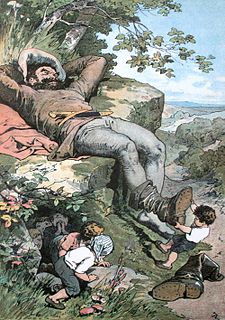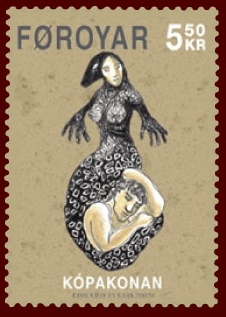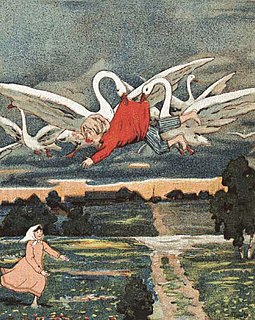Related Research Articles

A fairy tale, fairytale, wonder tale, magic tale, fairy story or Märchen is an instance of European folklore genre that takes the form of a short story. Such stories typically feature mythical entities such as dwarfs, dragons, elves, fairies, giants, gnomes, goblins, griffins, mermaids, talking animals, trolls, unicorns, or witches, and usually magic or enchantments. In most cultures, there is no clear line separating myth from folk or fairy tale; all these together form the literature of preliterate societies. Fairy tales may be distinguished from other folk narratives such as legends and explicit moral tales, including beast fables.
The redcap is a type of malevolent, murderous goblin found in Border folklore. He is said to inhabit ruined castles along the Anglo-Scottish border, especially those that were the scenes of tyranny or wicked deeds and is known for soaking his cap in the blood of his victims. He is also known as Redcomb and Bloody Cap.

In Celtic and Norse mythology, selkies or selkie folk meaning 'seal folk' are mythological beings capable of therianthropy, changing from seal to human form by shedding their skin. They are found in folktales and mythology originating from the Northern Isles of Scotland.

Irish folklore refers to the folktales, balladry, music, dance, and so forth, ultimately, all of folk culture.
The Aarne–Thompson–Uther Index is a catalogue of folktale types used in folklore studies. The ATU Index is the product of a series of revisions and expansions by an international group of scholars: Originally composed in German by Finnish folklorist Antti Aarne (1910); the index was translated into English, revised, and expanded by American folklorist Stith Thompson ; and later further revised and expanded by German folklorist Hans-Jörg Uther (2004). The ATU Index, along with Thompson's Motif-Index of Folk-Literature (1932) is an essential tool for folklorists.

The church grim is a guardian spirit in English and Nordic folklore that oversees the welfare of a particular Christian church, and protects the churchyard from those who would profane and commit sacrilege against it. It often appears as a black dog but is known to take the form of other animals. In modern times, when black dogs are kept as pets in churches and their attached parsonages, these are called church grims since they reside on and guard ecclesiastical property.
Katharine Mary Briggs was a British folklorist and writer, who wrote The Anatomy of Puck, the four-volume A Dictionary of British Folk-Tales in the English Language, and various other books on fairies and folklore. From 1969 to 1972, she was president of the Folklore Society, which established an award in her name to commemorate her life and work.

"The Three Spinners" is a German fairy tale collected by the Brothers Grimm in Grimm's Fairy Tales. It is Aarne–Thompson type 501, which is widespread throughout Europe.

"The Master Maid" is a Norwegian fairy tale collected by Peter Christen Asbjørnsen and Jørgen Moe in their Norske Folkeeventyr. "Master" indicates "superior, skilled." Jørgen Moe wrote the tale down from the storyteller Anne Godlid in Seljord on a short visit in the autumn of 1842. Andrew Lang translated the tale to English and included it in his The Blue Fairy Book (1889). A later translation was made by George Dasent, in his Popular Tales from the North.

The Magic Swan Geese or Гуси-лебеди is a Russian fairy tale collected by Alexander Afanasyev in Narodnye russkie skazki, numbered 113.

"The Peasant's Wise Daughter", "The Peasant's Clever Daughter" or "The Clever Lass" is a German fairy tale collected by the Brothers Grimm in Grimm's Fairy Tales as tale number 94. It has also spread into Bohemia and Božena Němcová included it into her collection of Czech national folk tales in 1846.
"The Three Aunts" is a Norwegian fairy tale collected by Peter Christen Asbjørnsen and Jørgen Moe in Norske Folkeeventyr.
A kilmoulis is, in the folklore of the Anglo-Scottish border, an ugly version of the brownie who is said to haunt mills. He has an enormous nose and no mouth. This lack of an orifice forces him to inhale his food through his nose. The Kilmoulis works hard for the miller, but also delights in tricks and pranks. While his pranks may be a hindrance, he is generally enough help to offset the food he eats and the disturbances he causes. In popular culture, it was used in the Dungeons & Dragons game as a fey creature. A version of the kilmoulis appears in the video game Folklore.
A hob is a type of small mythological household spirit found in the north and midlands of England, but especially on the Anglo-Scottish border, according to traditional folklore of those regions. They could live inside the house or outdoors. They are said to work in farmyards and thus could be helpful; however, if offended they could become nuisances. The usual way to dispose of a hob was to give them a set of new clothing, the receiving of which would make the creature leave forever. It could, however, be impossible to get rid of the worst hobs.
In the folklore of Northumbria, the Sockburn Worm was a ferocious wyvern that laid waste to the village of Sockburn in Durham. It was said that the beast was finally slain by John Conyers. The tale is said by many to be the inspiration for Lewis Carroll's poem Jabberwocky which he wrote while in Croft-on-Tees and Whitburn.

A goblin is a monstrous creature that appears in the folklore of multiple European cultures, first attested in stories from the Middle Ages. They are ascribed various and conflicting abilities, temperaments and appearances depending on the story and country of origin. They are almost always small and grotesque, mischievous or outright malicious, and greedy, especially for gold and jewelry. They often have magical abilities similar to a fairy or demon. Similar creatures include brownies, dwarfs, duendes, gnomes, imps, and kobolds.
In the folklore on the Anglo-Scottish border, the Brown Man of the Muirs is a dwarf who serves as a guardian spirit of wild animals.

Hachikazuki or Hachi Katsugi is a Japanese folktale of the Otogi-zōshi genre. It refers to a maiden of noble birth who wears a bowl on her head and marries a prince.

Shobhanasundari Mukhopadhyay was an Indian writer, known for her collections of folktales. She was the daughter of Hemendranath Tagore and the niece of writer Rabindranath Tagore.
References
- 1 2 Notes on the folk-lore of the northern counties of England and the borders, William Henderson, Longmans, Green, 1866. pp. 4-5
- 1 2 Notes on the folk-lore of the northern counties of England and the borders, William Henderson, Longmans, Green, 1866. pp. 221-226
- 1 2 3 A companion to the fairy tale, Hilda Ellis Davidson, Anna Chaudhri, DS Brewer, 2006, ISBN 1-84384-081-2, ISBN 978-1-84384-081-7. page. 107
- Katharine Briggs, An Encyclopedia of Fairies, Hobgoblins, Brownies, Bogies, and Other Supernatural Creatures, "Habetrot", pp213–216 ISBN 0-394-73467-X.